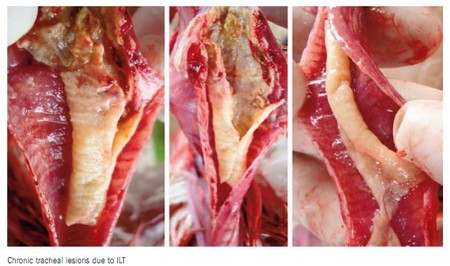Running interference against ILT
Published: January 16, 2012
Source : broilerhealth.com
New research from the University of Georgia indicates that multivalent vaccination can hinder immunity against infectious laryngotracheitis.
Producers should reduce the number and diversity of live-virus vaccines given in the field when also vaccinating for infectious laryngotracheitis (ILT), investigators from the University of Georgia advise.
In their study, Dr. Guillermo Zavala and colleagues at the university's Poultry Diagnostic and Research Center sought to identify factors that interfere with protection against ILT, the highly contagious and costly respiratory disease of poultry that's been a growing problem for commercial producers on the American continent.
 The investigators found that simultaneous administration of live Newcastle disease (ND), infectious bronchitis (IB) and ILT vaccines interfered with the immunity produced by tissue-culture-origin ILT vaccines. Protection against ILT was not compromised after multivalent vaccination when the ILT vaccine was of chicken-embryo origin.
The investigators found that simultaneous administration of live Newcastle disease (ND), infectious bronchitis (IB) and ILT vaccines interfered with the immunity produced by tissue-culture-origin ILT vaccines. Protection against ILT was not compromised after multivalent vaccination when the ILT vaccine was of chicken-embryo origin.However, results of the study, conducted for the US Poultry & Egg Association, indicate both tissue-culture- and chicken-embryo-origin ILT vaccines depressed the antibody response to ND and IB disease, suggesting mutual interference.
The research suggests that one reason for inadequate control of ILT - and possibly other viral respiratory diseases - may be inadequate immunization resulting from multivalent vaccination, the investigators say in their report.
"These results are important for the poultry industry since multivalent vaccinations [particularly ND and IB live-virus vaccines], along with simultaneous ILT vaccinations, are routinely practiced in areas experiencing outbreaks of ILT," says Zavala and colleagues Drs. Maricarmen Garcia and Ariel Vagnozzi.
PRODUCER OPTIONS
To optimize protection against ILT, Zavala tells Broiler Health, producers have several options.
To optimize protection against ILT, Zavala tells Broiler Health, producers have several options.
Besides reducing the number of vaccinations given in areas where ILT is a severe problem, they could separate ILT vaccines from others given in the field by at least 5 to 7 days. "This is possible in broilers that have a cycle of 49 days or longer. It may not be possible in broilers that are marketed at younger ages," he says.
For long-lived chickens such as layers and broiler-breeders, "ILT vaccines should be administered separately," he continues, noting that "live, attenuated ILT vaccines may be applied simultaneously with some live MG [Mycoplasma gallisepticum] vaccines."
Another option is vaccination against ILT with a recombinant vaccine, such as Intervet/Schering-Plough Animal Health's Innovax-ILT, which is administered in ovo to 18-day embryos or by subcutaneous injection to day-old chicks.
"In ovo vaccination with a recombinant vaccine is a suitable alternative," Zavala says. In broilers, administration of a recombinant vaccine in the hatchery is routinely used in some areas where ILT is enzootic, he continues.
"For long-lived birds, however, it may be necessary to strengthen immunity against ILT by vaccinating with a recombinant vaccine in the hatchery and boosting in the field with a live, attenuated vaccine," he says.
DON'T LOWER LIVE VACCINE DOSE
Another important finding in the study was that field ILT virus infection of the trachea at a lower versus higher dose persists longer in the tissues before it is neutralized.
"This finding is relevant because some in the broiler industry frequently lower ILT vaccine doses on the premise that vaccine reactions may be lessened," the investigators say. It is known, however, that a high titer of ILT virus vaccine is needed to get a prompt, neutralizing immune response. "Thus, over-dilution or ‘cutting' of vaccine would seem to be counterproductive."
The investigators base this advice upon field testing of an ILT virus strain known as 63140 that's been circulating in the field, resulting in significant losses to the regional broiler industry. The virus was more virulent than the USDA's standard challenge strain of ILT and had an incubation period of only 2 or 3 days, which is much shorter than the incubation period reported for the ILT virus in previous experiments and in the literature, Zavala and colleagues say.
SEROLOGY FOR ILT SCREENING
The investigators' last finding is based on a survey involving the state of Georgia.Antibodies against the ILT virus were detected only in poultry operations within the so-called "vaccination zone" or "ILT zone," leading to the conclusion that serology may be used as a screening tool for epidemiological studies.
Zavala says ILT serology using currently available tools, such as the ELISA, may be used only as a screening test in areas where ILT is not known to be a problem.
"ELISA testing may reveal seroconversion in flocks that were not vaccinated and were exposed to field ILTV. Although this should never be used as a sole diagnostic approach, it may be a rapid way of screening a large number of flocks while attempting to investigate possible disease agents in a given area," he says.
ELISA antibodies are not known to have an adequate predictive value in terms of actual protection against ILTV in the field. Thus, once ILT has been diagnosed in a given area, other confirmatory tests such as PCR, histopathology, immunofluorescence, immunocytochemistry or virus isolation constitute the diagnostic tests of choice, Zavala cautions.


The results of this research were published in Broiler Health magazine. Engormix.com thanks the magazine for this contribution.
Source
broilerhealth.comRelated topics:
Mentioned in this news release:
Recommend
Comment
Share
27 de enero de 2012
A very informative article with some sound advices. It is also clear from the article that in-ovo inoculation of some vaccines are more beneficial than conventional routes. Another important lesson in this article is that there should not be any intervention in the technique of vaccination recommended by manufacturing companies. There is huge research involved before a product is finalized for commercial use but still you find someone with limited knowledge or resources regarding research to change the method. This practice is very dangerous and must not be allowed.
Recommend
Reply
Recommend
Reply
Recommend
Reply
Recommend
Reply

Would you like to discuss another topic? Create a new post to engage with experts in the community.












.jpg&w=3840&q=75)